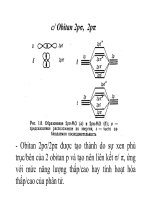Bài giảng hoá học hữu cơ alkanes
Bạn đang xem bản rút gọn của tài liệu. Xem và tải ngay bản đầy đủ của tài liệu tại đây (1.31 MB, 72 trang )
Chapter 2
2010
ALKANES
Outlines
Homologous series of alkanes
Isomerism
Nomenclature
Conformation of ethane
Laboratory preparation
Physical properties
Chemical reactions
Alkanes are hydrocarbons, they contain
only carbon and hydrogen.
The general formula is CnH2n+2 ( n≥1), n is an
integer.
Alkanes are also called alphatic
compounds, meaning “fat”.
Consist of only sp3 hybridized C and H
atoms connected by sigma bonds.
The simplest molecules is methane, CH4
natural gas), ethane (C2H6), propane (C3H8),
octane (C8H18 gasoline),…
4
Methane, ethane
form a significant portion of
the atmospheres of the outer gas planets.
Jupiter, Saturn, Uranus, Neptune (1.5%
methane, 1.5 ppm ethane).
Some alkanes form through the slow
decomposition of organic substances
(wood, lignite and mineral coal).
The most important commercial sources
for alkanes are natural gas and oil.
Homologous series
What is a homologous series?
A homologous series is a series of organic
compounds with a similar general formula,
possessing similar chemical properties due to the
presence of the same functional group, and
shows a gradation in physical properties as a
result of increase in molecular size and mass.
Homologous series
If one hydrogen atom from methane (CH4) is
4
replaced by a methyl radical, -CH3 the new
hydrocarbon will have the composition CH3CH3 (C2H6) named ethane.
Homologous series
If one hydrogen atom from ethane is
replaced by a methyl radical -CH3, the new
hydrocarbon propane CH3-CH2-CH3 (C3H8)
will be obtained.
If you continue the successive substitution
of one H atom from the hydrocarbon with
one radical -CH3 you will obtain a series of
hydrocarbons, each different from one
another with one group of CH2.
Alkanes belong to a
homologous series of
organic compounds in which the members
differ by a constant atomic mass of 14.
Homologous series
Methane CH4
Ethane CH3-CH3
Propane CH3-CH2-CH3
Butane CH3-CH2-CH2-CH3
Pentane CH3-CH2-CH2-CH2-CH3
Hexane CH3-CH2-CH2-CH2-CH2-CH3
Heptane CH3-CH2-CH2-CH2-CH2-CH2-CH3
Octane CH3-CH2-CH2-CH2-CH2-CH2-CH2-CH3
Nonane CH3-CH2-CH2-CH2-CH2-CH2-CH2-CH2-CH3
Isomerism
What is the isomers ?
Isomers are compounds that have the
same numbers and kinds of atoms but
differ in the way the atom arranged.
Isomerism
Isomeric Alkanes
- Alkanes with more than 3 carbon atoms
can be arranged in a multiple number of
ways, forming different structural isomers
(constitutional isomers).
Constitutional isomers: differ in order of
attachment of atoms.
The carbon atoms in alkanes can be
arranged in a straight chain.
This isomer is called the n-isomer
(n for "normal").
The chain of carbon atoms may also be
branched at one or more points
(e.g, branched chain).
CH3 - CH3 - CH2 - CH3
n-Butane
CH3 - CH - CH3
CH3
Isobutane
The number of possible isomers increases
rapidly with the number of carbon atoms.
C1-C3: 1 isomer
C4: 2 isomers, n-butane and isobutane
C12: 355 isomers
C32: 27,711,253,769 isomers
C60: 22,158,734,535,770,411,074,184
isomers, many of which are not stable.
Nomenclature
The trivial name for alkanes is "paraffins".
Trivial names are usually historical
artifacts. They’ve been retained due to
familiar usage in industry.
The first four alkanes with a unbranched
chain are called:
methane, ethane, propane, butane.
Alkanes with five or more carbon atoms are
named by adding the ending “-ane” to the
appropriate Greek-numeric prefix.
pentane is the five carbon alkane,C5H12
hexane is the five carbon alkane, C6H14
heptane, C7H16; octane, C8H18;...
The alkane names form the basic for
naming all other organic compounds, so at
least the first ten should be memorized.
For the hydrocarbons without branch, use the
prefix “ n-”+ the name of the hydrocarbon.
For the hydrocarbons with two methyl
groups (-CH3) at the end of a linear chain;
use the prefix “iso-”+ the name of the
hydrocarbon.
iso -pentane
For those containing three -CH3
groups at
the end of the chain; use the prefix “neo-”
+ the name of the hydrocarbon.
3
neo –hexane
Primary
carbon (1°) - linked to one other
carbon, CH3-CH3.
Secondary
carbon (2°) - linked to two other
carbons, CH3-CH2-CH3
Tertiary
carbon (3°) - linked to three other
carbons, (CH3)2-CH-CH3
Quaternary
carbon (4°) - linked to four
other carbons, (CH ) -C-CH
Alkyl groups
If one hydrogen atom is removed from an
alkane, the partial structure that remains is
called an alkyl group.
They are named by the replacement of the
ending “-ane” from the hydrocarbon’s name
with the ending “-yl”.
Alkyl groups are not stable compounds
themselves, they simply parts of larger
compounds.
Removal of a hydrogen atom from the
carbon of an n-alkane gives an n-alkyl
group.
end
Branched alkyl groups are generated by
removing a hydrogen from an internal
carbon.
Two 3-carbon alkyl groups are possible:
n-propyl and isopropyl groups
Four 4-carbon alkyl groups:
The prefixes sec- (for
secondary) and tert- (for
tertiary) used for the C4
alkyl groups refer to the
number of other carbon
atoms attached to the
branching carbon atom.
IUPAC nomenclature of
Organic compounds
IUPAC is the abbreviation of International
Union of Pure and Applied Chemistry









